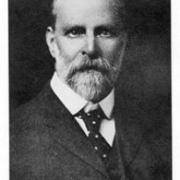History
A HISTORY OF SEARLES SCHOOL & CHAPEL
 Constructed between 1907-1909, Searles School and Chapel was donated to the town of Windham by the
Constructed between 1907-1909, Searles School and Chapel was donated to the town of Windham by the
philanthropist and Methuen native Edward Francis Searles (1841-1920).h
Searles was assembling what was to be a 1200 acre estate that surrounded the existing school house #1 of six in those days.
He proposed to the town that he would donate a new structure in exchange for the old. The offer was accepted in November 1906 and the building (According to Searles , it cost over $40,000.00.) was completed in early 1909.
Designed in the Gothic Revival style by the preeminent English expatriate architect Henry Vaughan, it served as a schoolhouse until the early 1970’s. When it no longer served its intended purpose it was threatened with demolition. It averted that fate when its restoration was named by the Windham Bicentennial Commission as it’s primary project. After the bicentennial, the Windham Historic Commission was created to continue the process. In 1982 it was added to the National Register of Historic Places.
It serves a great example of re-purposing of a landmark municipal building, while retaining it’s integrity and generating revenue through it’s use as an events venue.
About Henry Vaughan
 Born in England, Henry Vaughan (1845-1917) immigrated to the United States in 1881. His first commission in that year was the Chapel for the Episcopal Sisters of Saint Margaret on Louisburg Square in Boston. The chapel is now part of the home of Teresa Heinz and Secretary of State John Kerry. Even though he practiced in the United States until his death in 1917, Vaughan’s style remained very English. He did not adapt to other architectural styles of the time. “He was, in short an English architect who happened to work in America.”
Born in England, Henry Vaughan (1845-1917) immigrated to the United States in 1881. His first commission in that year was the Chapel for the Episcopal Sisters of Saint Margaret on Louisburg Square in Boston. The chapel is now part of the home of Teresa Heinz and Secretary of State John Kerry. Even though he practiced in the United States until his death in 1917, Vaughan’s style remained very English. He did not adapt to other architectural styles of the time. “He was, in short an English architect who happened to work in America.”
Searles Chapel, Date Unknown
Searles School & Chapel Today